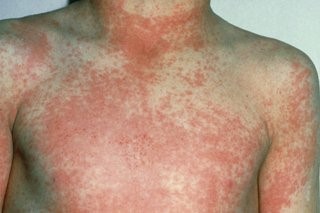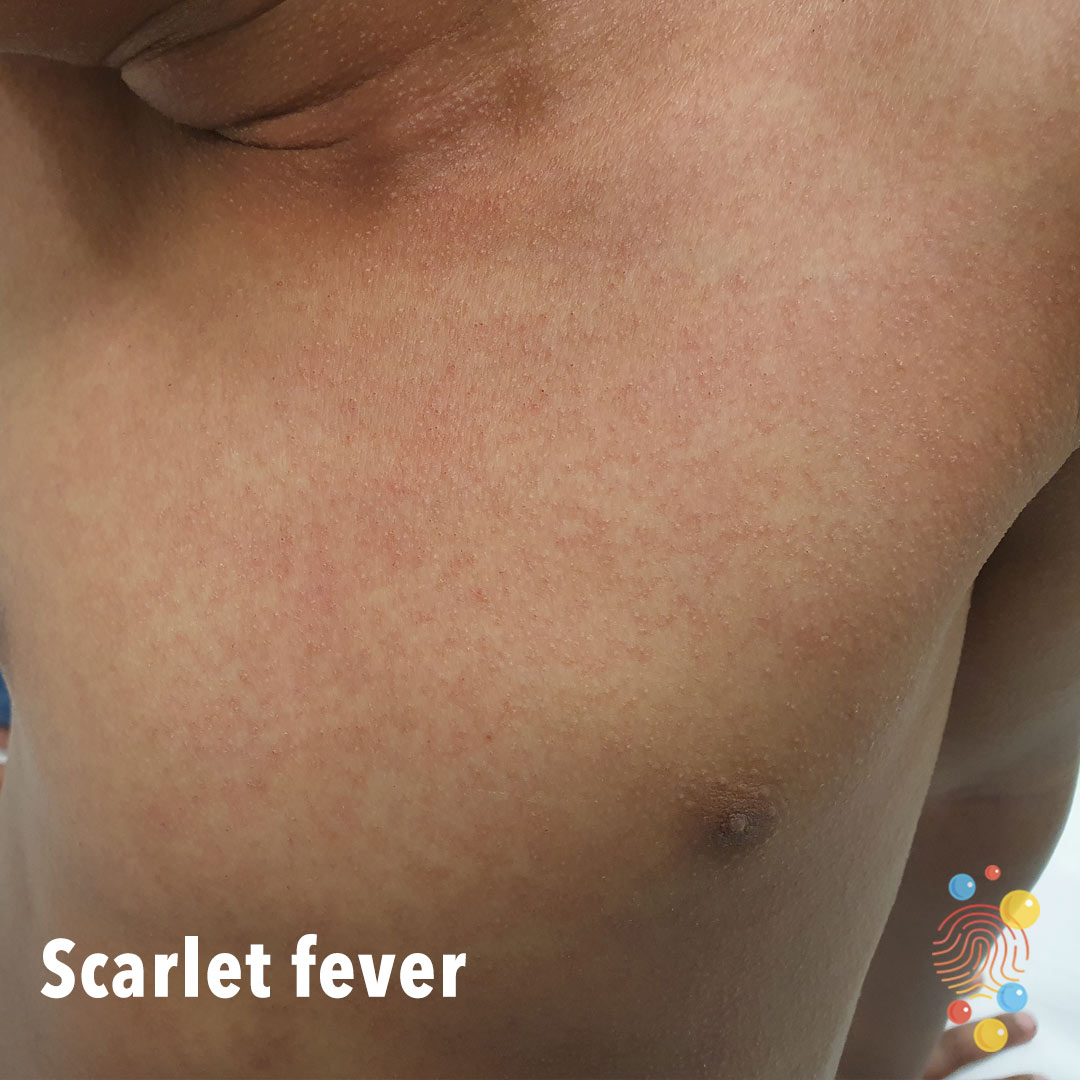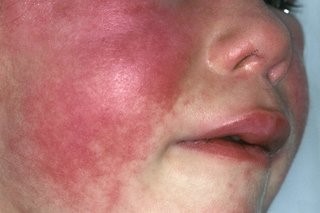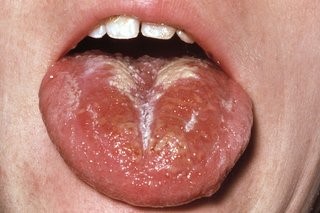Scarlet Fever
Every few years we see the Scarlet Fever condition affect an increasing number of children and it is much more common in children than in adults. It is important that children with scarlet fever are seen by their GP so that they can be started on antibiotics. This is not only to reduce the chance of the infection becoming severe but also to stop them from spreading the infection to others.
Scarlet fever is an illness is caused by a bug called group A streptococcus, which are found on the skin and in the throat. Scarlet fever mostly affects children and can easily spread to other people (contagious).
The signs of scarlet fever usually take two to five days to appear after infection.
Common signs include:
- Sore throat or Tonsillitis
- Fever (38oC or above)
- Headache
- Flushed face/ swollen tongue
- Rash (develops over 1-2 days)
Rash
Red blotches are the first sign of the rash. These turn into a fine pink-red rash that looks like sunburn on white skin. It may be harder to see on brown and black skin. The rash feels like sandpaper to touch and it may also be itchy.
The rash usually starts in the chest and tummy, but soon spreads to other parts of the body.


The rash doesn't usually spread to the face. However, the cheeks become flushed and the area just around the mouth stays quite pale (Peri-oral pallor)

The rash will turn white if you press a glass on it. The rash usually fades after about a week, but the outer layers of skin, usually on the hands and feet, may peel for several weeks afterwards.
Strawberry Tongue
A white coating on the tongue, which peels a few days later leaving the tongue red and swollen (this is known as strawberry tongue)

In milder cases, the rash may be the only symptom.
Images in this section are from DermNet and Don't Forget the Bubbles, used with permission.
When should you worry?
If your child has any of the following:
- Unable to swallow saliva
- Breathing very fast or breathing that stops or pauses
- Working hard to breathe, drawing in of the muscles below the rib, unable to talk or noisy breathing (grunting)
- A harsh breath noise as they breathe in (stridor) present all of the time (even when they are not upset)
- Becomes pale, blue, mottled and/or unusually cold to touch
- Difficult to wake up, very sleepy or confused
- Weak, high-pitched, continuous cry or extremely agitated
- Has a fit (seizure)
- A temperature less than 36oC or temperature 38oC or more if baby is less than 3 months
You need urgent help.
Go to the nearest Hospital Emergency (A&E) Department or phone 999
If your child has any of the following:
- Painful, red swollen neck glands
- Painful, swollen joints
- Puffy face/eyelids or dark coca-cola coloured wee (urine)
- Develops red lips or a red tongue
- Breathing a bit faster than normal or working a bit harder to breathe
- Noisy breathing (stridor) only when upset
- Dry skin, lips, tongue or looking pale
- Not had a wee or wet nappy in last 12 hours
- Sleepy or not responding normally
- Crying and unsettled
- Poor feeding (babies) or not drinking (children)
- A temperature 39oC or above in babies 3-6 months
- Temperature of 38oC or above for more than 5 days or shivering with fever(rigors)
- Getting worse or you are worried about them
You need to contact a doctor or nurse today.
Please ring your GP surgery or call NHS 111 - dial 111
If none of the above features are present
Watch them closely for any change and look out for any red or amber symptoms
Self care
Continue providing your child’s care at home. If you are still concerned about your child, call NHS 111 – dial 111
What should you do?
- If you think your child has Scarlet Fever, they should be assessed at their GP surgery. Scarlet Fever needs to be treated with antibiotics. Liquid antibiotics like penicillin or amoxicillin are used to treat children. These must be taken for 10 days, even though most children recover after 4-5 days
- To make your child more comfortable, you may want to use paracetamol and/or ibuprofen. Use one and if your child has not improved 2/3 hours later you may want to try giving the other medicine. However, remember that fever is a normal response that may help the body to fight infection and paracetamol/ibuprofen will not get rid of it entirely.
- Avoid tepid water sponging your child - it doesn't actually reduce your child's temperature and may cause your child to shiver.
- Encourage them to drink plenty of fluids.
How long will your child's symptoms last?
Scarlet Fever lasts for around 1 week. If you do not take antibiotics, you can spread the infection for 2-3 weeks after your symptoms start.
Important
Keep your child away from nursery or school for at least 24 hours after starting antibiotic treatment. Adults with Scarlet Fever should also stay off work for at least 24 hours after starting treatment.
Care at Home
Many of the symptoms of scarlet fever can be relieved using some simple self-care measures, such as:
- drinking plenty of cool fluids
- eating soft foods (if your throat is painful)
- taking paracetamol if required
- using calamine lotion or antihistamine tablets to relieve itching
Is Scarlet Fever dangerous?
Most cases of Scarlet Fever don't cause problems, particularly if the condition is properly treated. However, there's a small risk of the infection spreading to other parts of the body and causing more serious infections, such as an ear infection, sinusitis ( Inflammation of sinuses) or chest infection. Some of the problems can arise a few weeks after infection including kidney problems, joint issues – please get in touch with your GP Surgery if you are concerned.
How to avoid spreading Scarlet Fever?
Scarlet Fever is very contagious and can easily spread to other people. To reduce the chance of spreading Scarlet Fever:
Do:
- wash your hands often with soap and water
- use tissues to trap germs from coughs or sneezes
- bin used tissues as quickly as possible
Don’t:
- do not share cutlery, cups, towels, clothes, bedding or baths with anyone who has symptoms of scarlet fever
Further Information
Where should you seek help?
- If it is non-urgent speak to your local pharmacist or health visitor
- If your child has any of the above features, urgently see your GP. For an urgent out-of-hours GP appointment, call NHS 111
- You should only call 999 or go to your nearest A&E department in critical or life threatening situations
For wear and tear, minor trips and everything in between.
Self-care
You can treat your child's very minor illnesses and injuries at home.
Some illnesses can be treated in your own home with support and advice from the services listed when required, using the recommended medicines and getting plenty of rest.
Sound advice
Children can recover from illness quickly but also can become more poorly quickly; it is important to seek further advice if a child's condition gets worse.
For information on common childhood illnesses go to What is wrong with my child?
Pharmacists are experts in many aspects of healthcare and can offer advice on a wide range of long-term conditions and common illnesses such as coughs, colds and stomach upsets. You don’t need an appointment and many have private consultation areas, so they are a good first port of call. Your pharmacist will say if you need further medical attention.
Sound advice
- Visit a pharmacy if your child is ill, but does not need to see a GP.
- Remember that if your child's condition gets worse, you should seek further medical advice immediately.
- Help your child to understand - watch this video with them about going to the pharmacy.
For information on common childhood illnesses go to What is wrong with my child?
Health visitors are nurses or midwives who are passionate about promoting healthy lifestyles and preventing illness through the delivery of the Healthy Child Programme. They work with you through your pregnancy up until your child is ready to start school.
Health Visitors can also make referrals for you to other health professionals for example hearing or vision concerns or to the Community Paediatricians or to the child and adolescent mental health services.
Contact them by phoning your Health Visitor Team or local Children’s Centre.
Sound advice
Health visitors also provide advice, support and guidance in caring for your child, including:
- Breastfeeding, weaning and healthy eating
- Exercise, hygiene and safety
- Your child’s growth and development
- Emotional health and wellbeing, including postnatal depression
- Safety in the home
- Stopping smoking
- Contraception and sexual health
- Sleep and behaviour management (including temper tantrums!)
- Toilet training
- Minor illnesses
For more information watch the video: What does a health visitor do?
School nurses care for children and young people, aged 5-19, and their families, to ensure their health needs are supported within their school and community. They work closely with education staff and other agencies to support parents, carers and the children and young people, with physical and/or emotional health needs.
Primary and secondary schools have an allocated school nurse – telephone your child’s school to ask for the contact details of your named school nurse.
There is also a specialist nurse who works with families who choose to educate their children at home.
Sound Advice
Before your child starts school your health visitor will meet with the school nursing team to transfer their care to the school nursing service. The school nursing team consists of a school nursing lead, specialist public health practitioners and school health staff nurses.
They all have a role in preventing disease and promoting health and wellbeing, by:-
- encouraging healthier lifestyles
- offering immunisations
- giving information, advice and support to children, young people and their families
- supporting children with complex health needs
Each member of the team has links with many other professionals who also work with children including community paediatricians, child and adolescent mental health teams, health visitors and speech and language therapists. The school health nursing service also forms part of the multi-agency services for children, young people and families where there are child protection or safeguarding issues.
If you’re not sure which NHS service you need, call 111. An adviser will ask you questions to assess your symptoms and then give you the advice you need, or direct you straightaway to the best service for you in your area.
Sound advice
Use NHS 111 if you are unsure what to do next, have any questions about a condition or treatment or require information about local health services.
For information on common childhood illnesses go to What is wrong with my child?
A&E departments provide vital care for life-threatening emergencies, such as loss of consciousness, suspected heart attacks, breathing difficulties, or severe bleeding that cannot be stopped. If you’re not sure it’s an emergency, call 111 for advice.


